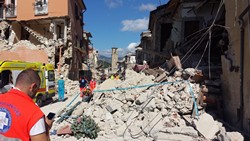Technologies to better bounce back from natural disasters
Natural disasters are on the rise. From earthquakes to flooding, volcanic eruptions, hurricanes or wildfires, these events have become the most tangible realisation of climate change, and the world has so far failed to approach this challenge in any other way than paying the damage bill. From 1991 to 2010, more than five times as much was spent on disaster response as on disaster risk reduction, according to UN figures. The consequences of this lack of planning are often tragic: In 2005, Hurricane Katrina struck the Gulf Coast region in the United States. It caused breaches in the flood protection system in New Orleans, resulting in substantial structural damage to residences in the immediate vicinity of these breaches. Approximately three quarters of the city was flooded. Bridges were damaged by the uplift, and industrial facilities such as seaports and petrochemical facilities also took a considerable hit. ‘The unprecedented state of emergency brought about by Katrina renewed focus on the need to address protection from the threat of natural disasters, in addition to man-made hazards,’ says Prof. Gian Paolo Cimellaro, associate professor at the Department of Structural, Geotechnical & Building Engineering of the Polytechnic University of Turin, and coordinator of IRUSAT (Improving Resilience of Urban Societies through Advanced Technologies). More specifically, the scientific community started to investigate the concept of resilience. ‘Several mitigation strategies already exist to improve the performance of infrastructures. These can be based, for example, on innovative technologies such as base isolation for bridges combined with the use of passive systems such as viscous dampers, hysteretic dampers, etc.,’ Prof. Cimellaro continues. ‘But while these methodologies are all able to reduce the physical damage caused by natural disasters, recent events have shown that most often physical damage cannot be avoided. This is where resilience — that is, the ability to bounce back from crisis — is required.’ Predicting the financial impact of disasters Finding an appropriate resilience strategy is not an easy task. As our societies rely on increasingly interdependent systems, resilience strategies need to first consider the risk of a domino effect. For each local or regional community, weak points of the economic system should be identified and protected so as to enhance economic resiliency in case of natural disasters. IRUSAT proposes a model to achieve just that, as Prof. Cimellaro explains. ‘Our model, which was applied to the San Francisco Bay Area, describes the economic effects and characteristics that should be taken into account to predict the monetary impact of natural disasters, focusing in particular on the economic interdependencies of industries and lifelines.’ The model uses multiple sources: real economic data provided by surveys on specific natural disasters, data on physical damage contained in the HAZUS database, and the Economic Resilience Index provided in the PEOPLES framework. A sensitivity analysis is performed for each economic sector considered in the analysis, and a final global economic resilience index is obtained. One of the main outcomes of the model resides in so-called ‘autonomy curves’: ‘We derived these from the probabilities of business closure obtained thanks to business surveys and simulations focused on our case study area,’ Prof. Cimellaro points out. Thanks to this work, the team is now able to propose IDEALCITY, a virtual city model that simulates all the main infrastructure interdependencies during a crisis caused by an extreme event. This is expected to help decision-makers to define strategies for reinforcing local and regional systems. ‘The focus should shift towards restoration strategies, trying to improve the speed of recovery and reduce the downtime of the infrastructures. This will be possible not only by focusing on reducing the structural and non-structural damage, but also by improving emergency responses from the likes of firefighters, police or civil protection. Technologies to better deal with emergencies A key contribution of IRUSAT in this regard consists of a wristband device and a customised ‘Structural health monitoring’ (SHM) system for managing emergencies. Fully independent from external power and communication networks, the system allows for indoor geolocation. This can be very useful for, say, firefighters entering buildings on fire and who might otherwise lose their sense of direction. ‘We are planning to test the technology on people wearing the device and positioned on a shaking table, in order to test the capacity of the device to collect and transfer the information through a radio frequency system during the shaking,’ Prof. Cimellaro explains. ‘Large-scale simulations are also planned to test the capacity of the system in a large-scale environment with a large number of users, and we will ask real firefighters from the Piedmont Region in Italy to participate.’ Besides the commercialisation of this device, the team hopes to be able to create a virtual city where rescue teams can monitor and improve their performance. ‘In the long term this tool will be used by decision-makers in real time, to verify the effect of their decisions during an emergency in a complex system such as a community,’ Prof. Cimellaro concludes.







